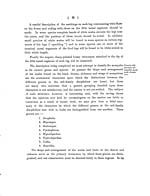Medicine - Disease > Malarial fevers
(38) Page 30
Download files
Individual page:
Thumbnail gallery: Grid view | List view

( 30 )
A detailed
examination
is necessary
for identifica-
tion.
Having ascertained that the specimen belongs to the sub-family Anophe-
lince the student will proceed with the minute examination necessary for
making a complete identification of the mosquito. In the examination of
the palpi it will be noted whether they are densely scaled or not and whether
they are uniformly coloured or encircled with white bands, and the number,
relative size, and position of such bands will be carefully described. In addi-
tion to definite bands a few white scaled patches may be present (as
" speckling ") on one or more segments of the palpi. Passing on to the
examination of the head the characters of the scales will be noted, and in
particular the characters of the upright forked scales (Plate IV, g & l) can
be readily made out. In most Anophelines a prominent tuft of white hairs
projecting forwards from the anterior end of the head will be seen. The
thorax will next be examined, and it will be noted whether the dorsum is
covered with scales or with hairs or with both, and the characters of these
structures will be described. Passing on to wards the abdomen the scutellum
will be examined; it will be seen that it is always simple-never trilobed as
in all other sub-families of the Culicid-and that it carries scales or hairs.
The bare horse-shoe shaped metanotum or post-scutellum will next be seen,
and then the halteres, the knobs of which are clothed with numerous small
scales. The examination of the abdomen is of great importance. In some
species, although the abdomen is thickly covered with long hairs, no scales
are present. In other species it will be seen that in addition to the hairs
covering the majority of segments a few scales can be discovered on the ventral
surface of the last one or two segments only. In other species, again, it
will be seen at once that the dorsum of each segment is thickly set with
white or golden-brown scales which in some species are very broad and in
others more or less spindle-shaped. (Plate IV, q & s.) It will readily be
recognised that the presence or absence and the character of these scales
is very important.
The wings and legs will next be examined. The best way to describe
the wings is to make a diagrammatic drawing showing the number and
relative width and position of the different dark and light-scaled areas on
each vein. (Plate IV, i.) The shape of the wing scales must be noted by
separate examination of a wing mounted under a cover glass.
A detailed
examination
is necessary
for identifica-
tion.
Having ascertained that the specimen belongs to the sub-family Anophe-
lince the student will proceed with the minute examination necessary for
making a complete identification of the mosquito. In the examination of
the palpi it will be noted whether they are densely scaled or not and whether
they are uniformly coloured or encircled with white bands, and the number,
relative size, and position of such bands will be carefully described. In addi-
tion to definite bands a few white scaled patches may be present (as
" speckling ") on one or more segments of the palpi. Passing on to the
examination of the head the characters of the scales will be noted, and in
particular the characters of the upright forked scales (Plate IV, g & l) can
be readily made out. In most Anophelines a prominent tuft of white hairs
projecting forwards from the anterior end of the head will be seen. The
thorax will next be examined, and it will be noted whether the dorsum is
covered with scales or with hairs or with both, and the characters of these
structures will be described. Passing on to wards the abdomen the scutellum
will be examined; it will be seen that it is always simple-never trilobed as
in all other sub-families of the Culicid-and that it carries scales or hairs.
The bare horse-shoe shaped metanotum or post-scutellum will next be seen,
and then the halteres, the knobs of which are clothed with numerous small
scales. The examination of the abdomen is of great importance. In some
species, although the abdomen is thickly covered with long hairs, no scales
are present. In other species it will be seen that in addition to the hairs
covering the majority of segments a few scales can be discovered on the ventral
surface of the last one or two segments only. In other species, again, it
will be seen at once that the dorsum of each segment is thickly set with
white or golden-brown scales which in some species are very broad and in
others more or less spindle-shaped. (Plate IV, q & s.) It will readily be
recognised that the presence or absence and the character of these scales
is very important.
The wings and legs will next be examined. The best way to describe
the wings is to make a diagrammatic drawing showing the number and
relative width and position of the different dark and light-scaled areas on
each vein. (Plate IV, i.) The shape of the wing scales must be noted by
separate examination of a wing mounted under a cover glass.
Set display mode to: Large image | Zoom image | Transcription
Images and transcriptions on this page, including medium image downloads, may be used under the Creative Commons Attribution 4.0 International Licence unless otherwise stated. ![]()
| India Papers > Medicine - Disease > Malarial fevers > (38) Page 30 |
|---|
| Permanent URL | https://digital.nls.uk/74558926 |
|---|




